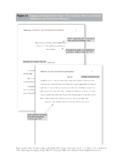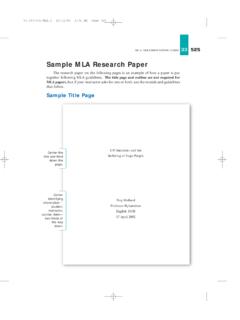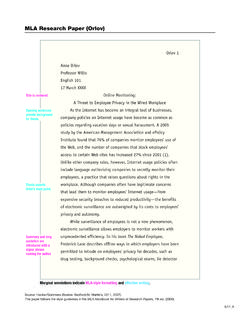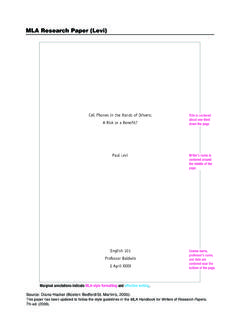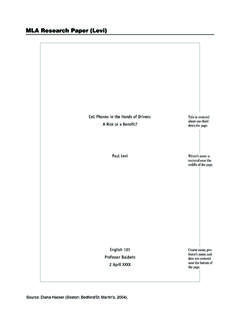Transcription of James Henry Breasted: Pioneer in the Study of Ancient ...
1 [SAMPLE OF A paper USING FOOTNOTES] James Henry Breasted: Pioneer in the Studyof Ancient EgyptianHistoryIma SoporificProf. PiccioneHistory 25, 2002[ , on first page of text only: 2-inch top margin & no page-number to be indicated]The field of Egyptology is only about 176 years old; thatis, only six generations have arisen since Jean-Fran oisChampollion completed the decipherment of Egyptian hieroglyphs in1824. Since then, Egyptologists have seen, generation bygeneration, the likes of Mariette, Lepsius, Petrie, breasted , ern&, Habachi, and all of their respective contemporaries whohave contributed their researches and understanding to the studyof Ancient Egypt. Now recent years have seen the torch ofenquiry pass to a new generation of scholars. However, even asscholarship continues to improve, and new standards of researchevolve, Egyptologists are always aware that they standacademically on the shoulders of their predecessors, accumulatingnew knowledge and insights and building upon and refining earlierinterpretations, as well as rejecting them where appropriate.
2 With these ideas in mind, the purpose of this paper is to placeinto historical context the work of Professor James HenryBreasted in the Study of Ancient Egypt, and, moreover, to showthat his two major works, A History of Egypt and the AncientRecords of Egypt actually mark a turning point in Egyptologicalstudies, inaugurating the era of modern Egyptology.[ .. etc., etc.. ]Although compared to Europe, America had come late toEgyptology and Near Eastern studies, breasted realized , James H. breasted , Editor s Forward, in AncientRecords of Assyria and Babylonia, vol. 1, Historical Records ofAssyria from the Earliest Times to Sargon, by Daniel (Chicago: The University of Chicago Press, 1926), H. breasted , The Oriental Institute of the Universityof Chicago: A Beginning and A Program.
3 Oriental InstituteCommunications 1 (Chicago: University of Chicago Press, 1922), [typewritten page-number first appears on second page of text, 1-inch margins all around]developing the scientific methodologies of this new approachcould be America's lasting contribution to these fields. In timeBreasted came to realize the need to establish a new institutefor the comprehensive Study of the Ancient Near East modeledalong the lines of scientific enquiry. Sometimes he evenreferred to this institute as a research laboratory. 1 Ultimately, he managed to convince some of the most rational ofpeople, , America's corporate industrial and commercialleaders, including John D. Rockefeller, Jr. (Standard Oil),Martin Ryerson (Inland Steel), and Julius Rosenwald (Sears andRoebuck).
4 By 1919, with their help, he founded the OrientalInstitute of The University of Here was aninternational center for broad-ranging interdisciplinary researchin the civilizations and languages of the Ancient Near East. [ .. etc., etc.. ]By 1905, breasted completed editing his compendium ofEgyptian historical texts, and between 1906 and 1907, hepublished it as the Ancient Records of Egypt: Historical3 James H. breasted , Ancient Records of Egypt: HistoricalDocuments from the Earliest Times to the Persian Conquest, fivevolumes (Chicago: University of Chicago Press, 1906-1907).4 James H. breasted , A History of Egypt: From the EarliestTimes to the Persian Conquest (New York: Scribners, 1905).3 Documents from the Earliest Times to the Persian However, as great and as useful as this collection was, it wasonly the second of two related publications that appeared withina year of each other.
5 Previously in 1905, breasted published AHistory of Egypt,4 which was his new and comprehensive Study ofEgyptian political and social history. In addition to beingremarkably well written, the strength of this work was that itwas exhaustively researched, and its argumentation was firmlygrounded on the full body of Egyptian historical texts, as theywere known then, and which breasted had translated according tothe highest grammatical standards of the day.[ .. etc., etc.. ]To this day, no other general history of Egypt has had a usefullifetime as extensive as breasted 's History of Egypt. Sixty-fiveyears after his death, breasted 's scholarship, although dated, isstill highly regarded, and as late as 1995, Who was Who inEgyptology cited it as, probably the best general history of5 Dawson, Warren R.
6 And Eric P. Uphill, Who was Who inEgyptology, A Biographical Index of Egyptologists, 3rd ed. Morris Bierbrier (London: Egypt Exploration Society, 1995), , Editor s Forward, Egypt ever published. 5 Even until today, A History ofEgypt is still useful in many History of Egypt and the Ancient Records of Egypt mark amilestone in the history of Egyptology. breasted 's methodologywas precise and well-considered. He intended the Ancient Recordsand A History of Egypt to be a related pair.[ .. etc., etc.. ]Late in the writing of the Ancient Records, breasted wasconvinced that the scope of the project should be broadened toinclude the texts of other cultures of the Ancient Near East.[ .. etc., etc.. ] breasted also planned to augment his five volumes of the Egyptianhistorical records with seven new volumes of records of othertypes (economic, religious, etc.)
7 6 However, the project was notto get off the ground anytime soon due to the untimely death ofHarper, compounded by the advent of World War I and then thelater reorganization of breasted s department and staff to foundthe Oriental Institute. It was not until 1926 that two volumesof the Ancient Records of Assyria and Babylonia appeared, edited5by Daniel D. Luckenbill. Unfortunately, these were the lastvolumes ever to be published in the Ancient Records spent ten years copying, collecting and translatingtexts for the Ancient Records of Egypt. Finally in 1904, heclosed the manuscript to further additions, and he began thefinal editing of the publication. Thereafter, the great work waspublished in five volumes, each volume appearing separately inprint from 1906 to 1907.
8 Volumes one to four contained thehistorical documents themselves arranged in chronological orderthrough the length of Egyptian history up to the Persian conquestof the sixth century Volume five consisted of variousindices and word-lists that make the corpus accessible forreference and research . The specific contents of the volumeswere divided as follows:Volume 1: Dynasties 1 to 17 (c. 3050-1570 )Volume 2: Dynasty 18 (c. 1570-1293 )Volume 3: Dynasty 19 (c. 1293-1185 )Volume 4: Dynasties 20-26 (c. 1185-525 )Volume 5: Indices and correctionsThe texts of each volume were arranged chronologically in orderof era or king's reign. [ .. etc., etc.. ]On the other hand, breasted prepared his renderings in a simpleidiomatic English that was easy for any person to comprehend.
9 As7 breasted , Ancient Records, vol. 1, The First throughSeventeenth Dynasties, , , Records of the Past: Being English Translations ofthe Assyrian and Egyptian Monuments. Published under the Sanctionof the Society of Biblical Arch ology, 12 volumes, ed. SamuelBirch (London: S. Bagster and Sons, 1874-1881); Records of thePast: Being English Translations of the Assyrian and EgyptianMonuments, new series, 6 volumes, ed. A. H. Sayce (London: and Sons, 1888-1992).6he noted in his preface, he consciously avoided any paraphrasingin his translations, a practice that he lamented was, otherwise,too common in his day. Rather, he stated that his effort was torender the Egyptian as literally as possible without wrenchingEnglish [ .. etc., etc.. ]As for comprehensiveness and consistency, prior to thepublication of the Ancient Records, there was no comparablecollection of translations of Egyptian texts in any language.
10 SoBreasted noted in his Preface to volume one, no attempt has everbeen made to collect and present all the sources of Egyptianhistory in a modern language 8 (italics added). Whilepreviously, Near Eastern scholars did collaborate to pool theirtranslations into single publications,9 they never included theentire corpus of any written genre, nor did the various scholarsregularize their translations to make them consistent with eachother. For these reasons, styles of translations differed from7text to text in the same compendia, and the same words might evenbe translated differently. In his volumes, breasted worked toovercome such limitations by being as inclusive as possible inhis choice of documents, as well as consistent in all histranslations. [ .. etc.]
